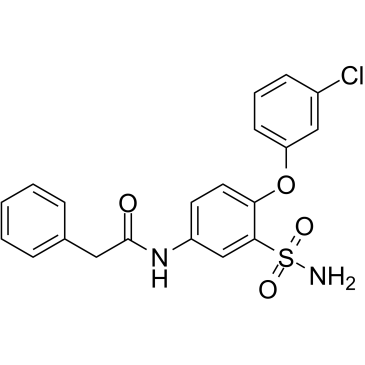| Description |
BAY-1797 is a potent, orally active, and selective P2X4 antagonist, with an IC50 of 211 nM against human P2X4. BAY-1797 displays no or very weak activity on the other P2X ion channels. BAY-1797 shows anti-nociceptive and anti-inflammatory effects[1].
|
| Related Catalog |
|
| Target |
IC50: 211 nM (human P2X4), >50 μM (human P2X1), >30 μM (human P2X23), 8.3 μM (human P2X3), 10.6 μM (human P2X7)[1]
|
| In Vitro |
BAY-1797 inhibits human, mouse, and rat P2X4 in 1321N1 cells with IC50s of 108 nM, 112 nM, and 233 nM, respectively[1]. BAY-1797 exerts no measurable activity on hERG and carbonic anhydrase II (both IC50>10 μM). BAY-1797 is also tested against a panel of off-targets, including G-protein coupled receptors (GPCRs), ion channels, kinases, and transporters at 10 μM. An inhibitory activity against the dopamine transporter (DAT, IC50 2.17 μM) was revealed as the only hit[1].
|
| In Vivo |
BAY-1797 (12.5-50 mg/kg; p.o.) shows a significant induction of PGE2 levels in the inflamed paw in the mouse Complete Freund’s Adjuvant (CFA) inflammatory pain model[1]. BAY-1797 (50 mg/kg; once daily for multiple p.o. administrations) induces a significant reduction of the ipsilateral paw load 24 and 48 h after CFA injection[1]. BAY-1797 treatment shows the AUCnorm, Vss and t1/2 are 1.06 kg h/L, 3.67 L/kg and 2.64 hours, respectively[1]. Animal Model: Female adult C57BL/6N mice (CFA inflammatory pain model)[1] Dosage: 12.5, 25, 50 mg/kg Administration: p.o.; once Result: Dose-dependently reduced PGE2 concentration in inflamed paw. Animal Model: Rat male Wistar[1] Dosage: 1 mg/kg Administration: i.v. (Pharmacokinetic Analysis) Result: The AUCnorm, Vss and t1/2 were 1.06 kg h/L, 3.67 L/kg and 2.64 hours, respectively.
|
| References |
[1]. Werner S, et al. Discovery and Characterization of the Potent and Selective P2X4 Inhibitor N-[4-(3-Chlorophenoxy)-3-sulfamoylphenyl]-2-phenylacetamide (BAY-1797) and Structure-Guided Amelioration of Its CYP3A4 Induction Profile. J Med Chem. 2019 Dec 26;62(24):11194-11217.
|
